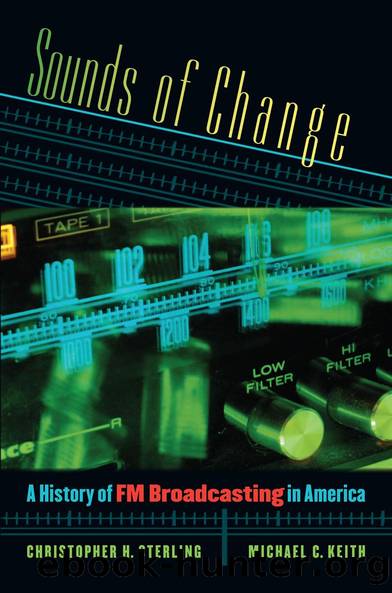Sounds of Change by Christopher H. Sterling Michael C. Keith

Author:Christopher H. Sterling, Michael C. Keith [Christopher H. Sterling, Michael C. Keith]
Language: eng
Format: epub
Tags: Social Science, Media Studies, Business & Economics, Industries, Media & Communications, Performing Arts, Radio, History & Criticism
ISBN: 9780807877555
Google: Ik-3w8ZwwqkC
Publisher: Univ of North Carolina Press
Published: 2009-09-15T05:34:27+00:00
ON THE MOVE
The logjam of historical barriers to FM development was clearly giving way by the 1970s. Building on the momentum already achieved, FMâs audience grew by leaps and bounds. Such success had numerous sources, although that was difficult to determine from the industry trade press. Broadcasting praised âstubborn [FM] believers and later ⦠owners of powerful AM stationsâ for making the difference,96 totally ignoring the FCCâs force-feeding of separate programmingâagainst which those same broadcast leaders had fought tooth and nail but which turned out to be the single most important factor in FMâs arrival as the dominant radio service. The commissionâs earlier decisions approving FM stereo standards (1961) and SCAS (1955) contributed to lifting FM out of decline. By finally resolving the decades-old controversy over program duplication, the FCC provided a crucial impetus for FMâs arrival as a commercial equal to AM service.
And how quickly the radio worm turned. Even at the start of the period covered in this chapter, established FM radio operators in major markets were already casting a jaundiced eye on the flood of newcomers that sought to further divide FMâs audience and still-limited revenue.97 Predictions that FM would surpass AM were widely heard once again.
Behind the scenes, however, a more subtle change was evident in this periodâthough it is understood more in retrospect than it was at the time. During the 1960s, FM was an exciting place to be, for while almost nobody made any money, neither were corporate bean counters breathing down programmersâ necks to toe a given company line or image. Experimentation was often encouraged or at least tolerated. FMâs âalternativeâ role to AM (and sometimes everything else) peaked in the 1960s and early 1970s. Then, as the financial signs for the medium improved, the flexibility and experimentation began to disappear in equal proportion. Once the medium was seen to have the potential to make money (by rising in market ratings and thus attracting more potential advertisers), it could no longer be treated as a programming sandbox. FM had to play radioâs game just as AM long had, pushing a few set-music formats (from soft rock in 1971 to disco in 1979, the latter viewed as the coup de grace by many old-line FM disciples) to grab the most desired audience groups. And it worked: FM became a great success by late in the 1970s, but at the cost (to many of its adherents) of losing its programming soul to the bean counters. As a California music magazine put it in mid-1978:
Corporate broadcasters are products of paranoia. The pressure on major market stations for those coveted ratings is incredible. Unfortunately, no matter what the ratings indicate, they will never speak for the entire mass market. They are an indicator, a barometer of base popularity. Not the final word, and hardly the gospel truth. And the ratings also make everyone forget that the people who listen to radio are not demographic numerical equivalents, marketing specifications, or jerks. Theyâre real flesh and blood souls who boogie to different drummers.
Download
This site does not store any files on its server. We only index and link to content provided by other sites. Please contact the content providers to delete copyright contents if any and email us, we'll remove relevant links or contents immediately.
| General Broadcasting | History & Criticism |
| Reference |
Childhood's End by Arthur C. Clarke(2064)
The Fellowship of the Ring (The Lord of the Ring, #1) by J.R.R. Tolkien(1764)
Childhood's end by Arthur C. Clarke(1645)
The Stars Are Fire by Anita Shreve(1631)
Tolkien, J. R. R. - The Fellowship of the Ring by Tolkien J. R. R(1519)
The Lord of the Rings: The Fellowship of the Ring, the Two Towers, the Return of the King by J. R. R. Tolkien(1410)
Howard Stern Comes Again (9781501194313) by Stern Howard(1398)
Ballet For Dummies by Scott Speck & Evelyn Cisneros(1389)
Black Privilege by Charlamagne Tha God(1335)
The Return of the King by J.R.R. Tolkien(1271)
Dark Fire by C.J. Sansom(1254)
Thunderstruck by Erik Larson(1233)
The Fellowship of the Ring (The Lord of the Rings, Book 1) by J. R. R. Tolkien(1211)
The Lord Of The Rings Part 03: The Return Of The King by J.R.R. Tolkien(1209)
Agatha Christie - 1945 - Sparkling Cyanide by Agatha Christie(1200)
Frenchman's Creek by Daphne Du Maurier(1187)
The Fellowship Of The Ring by J.R.R. Tolkien(1136)
Narnia 02 - The Lion, the Witch and the Wardrobe by C. S. Lewis(1135)
The Collected Raymond Chandler by Raymond Chandler(1126)
